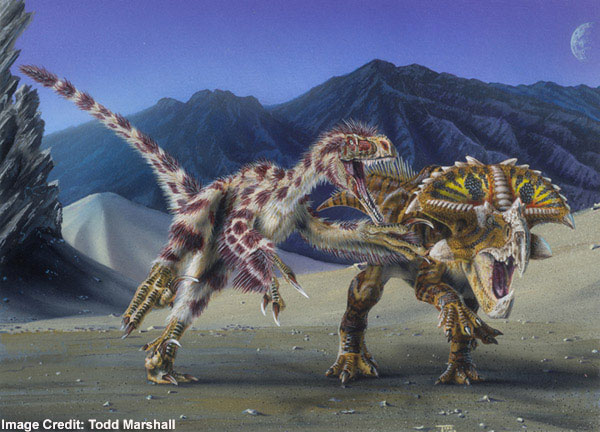
Tiny bumps on the fossilized arm bone of a Velociraptor specimen show that the carnivorous dinosaur—made infamous in the movie "Jurassic Park"—had feathers.
The finding, detailed in the Sept. 21 issue of the journal Science, confirms what scientists have long suspected about the creature as fossils of some of its close relatives bear imprints of feathers.
The researchers believe the bumps on the arm bone are remnants of quill knobs, places where the quills of secondary feathers—important for flight in many modern birds—were anchored to the bone.
"Finding quill knobs on Velociraptor means that it definitely had feathers," said study team member Alan Turner, a paleontology graduate student at the American Museum of Natural History and at Columbia University in New York. "This is something we'd long suspected, but no one had been able to prove."
Not for all birds
Quill knobs are most evident in modern birds that are strong flyers, such as falcons and hawks. Birds that have lost the ability to fly or that primarily soar, like broad-winged albatrosses, typically lack quill knobs.
While studying the forearm of a Velociraptor specimen unearthed in Mongolia in 1998, the researchers noticed six regularly spaced indentations in the fossilized bone that appeared remarkably similar to the quill knobs of modern birds.
Get the world’s most fascinating discoveries delivered straight to your inbox.
In modern birds, secondary feathers are connected to the forearm by way of ligaments. When the feathers move, they place stress on the bone. “The bones respond to the tug of the feathers by developing these little bumps,” Turner explained. “The quill knobs are a side effect of how the feathers anchor.”
Velociraptor lived during the late Cretaceous Period about 85 million years ago and belonged to a group of agile, bipedal dinosaurs called Dromaesoaurs that were closely related to birds. It was roughly the size of a turkey and weighed about 30 pounds.
A prehistoric turkey
Despite having feathers, Velociraptor could not fly or even glide, Turner said.
“Even though it had really long arms compared to most carnivorous dinosaurs, they’re not long enough compared to the rest of its body,” Turner told LiveScience.
The researchers suggest that an ancestor of Velociraptor might have lost the ability to fly but retained its feathers anyway. The feathers might also have been used for display, to shield nests, for temperature control or to help the dinosaur maneuver while running.
The new finding is just the latest example of how remarkably alike modern day birds and their closely related dinosaur ancestors were, said study team member Mark Norell, a curator in the AMNH’s Division of Paleontology.
“Both have wishbones, brooded their nests, possess hollow bones and were covered in feathers,” Norell said. "If animals like Velociraptor were alive today our first impression would be that they were just very unusual looking birds."
- IMAGE GALLERY: Dinosaur Fossils
- Avian Ancestors: Dinosaurs that Learned to Fly
- Birds of Prey: Spot Today’s Dinosaurs
 Live Science Plus
Live Science Plus





